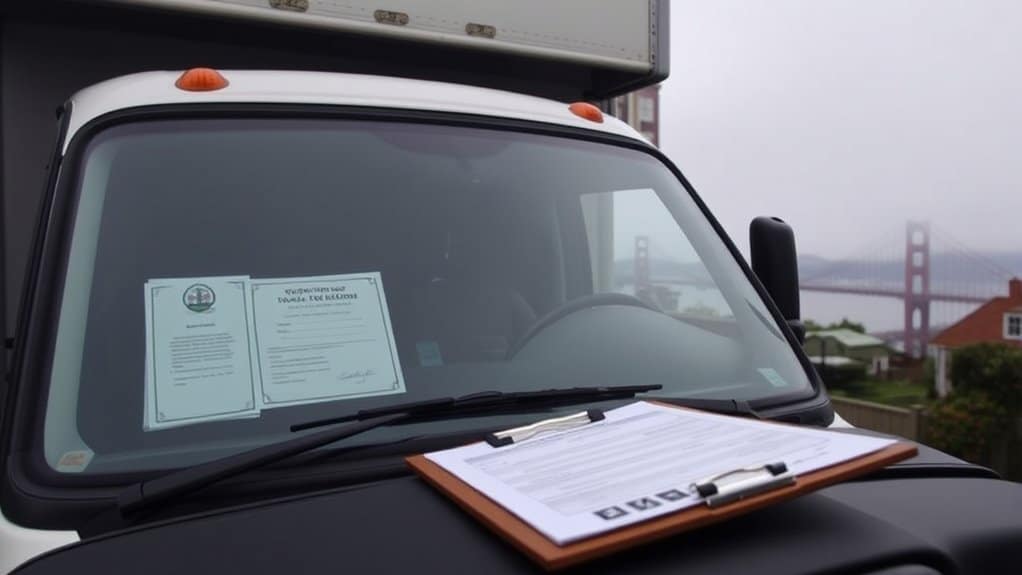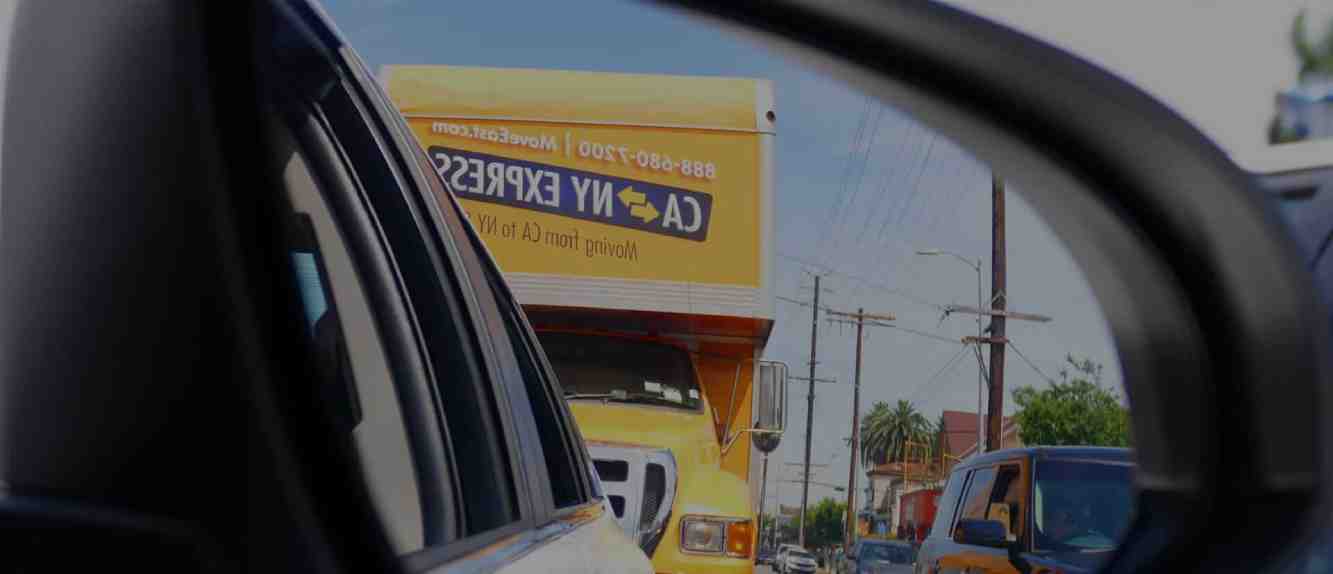Moving to San Francisco requires several key legal updates. You'll need to register your vehicle within 20 days, secure proper moving permits through SFMTA, and establish California residency after one year. As a tenant, you're protected by rent control laws and eviction safeguards. Immigration compliance includes updating your address with USCIS within 10 days. San Francisco's sanctuary city status offers unique protections, but federal program limitations still apply. Let's explore these requirements in detail.
Moving Company Permit Requirements

When planning a move to San Francisco, you'll need to navigate a complex system of permits and regulations that govern both moving companies and residents.
Moving permit regulations require companies to hold specific licenses from both the California PUC and SFPD, ensuring they meet strict operational standards.
Your chosen moving company must demonstrate compliance obligations by maintaining proper insurance coverage, passing written exams on tariff rates, and adhering to local traffic laws.
For moves within SF, you'll need two separate permits - one for each location. Companies must show proof of financial stability and undergo regular inspections by authorities.
While movers handle PUC requirements themselves, you're responsible for securing necessary street parking permits through SFMTA's online portal at least five business days before your move date.
Immigration Status Compliance
As San Francisco welcomes new residents, you'll need to understand essential immigration compliance requirements that affect both documented and undocumented individuals.
Starting April 2025, if you're a non-U.S. citizen over 14 staying longer than 30 days, you must register with USCIS and carry your immigration documentation at all times. Non-compliance can result in fines up to $5,000.
You're required to notify USCIS within 10 days of moving using Form AR-11, and you'll need fingerprinting through Form G-325R.
While these rules may seem strict, SF offers various protections. You can't be discriminated against in housing based on your status, and landlords can't ask about your immigration status.
If you need help managing these requirements, free legal resources are available through SF.gov's Immigrant Services.
California Residency Guidelines
To establish California residency, you'll need to prove you've lived continuously in the state for more than one year before your intended term starts.
Your documentation, including utility bills, leases, and state IDs, must be dated at least one year and one day prior to your term's beginning.
You'll also have to show you're making California your permanent home by registering to vote, getting a California driver's license, and maintaining employment or other significant ties to the state.
Establishing Primary Residence
Successfully establishing primary residence in California requires both physical presence and clear intent to make the state your permanent home.
You'll need to demonstrate residency intent through specific actions that support your domicile determination, including updating your voter registration, bank accounts, and vehicle registration to your California address.
To strengthen your position as a California resident, you'll want to maintain employment within the state, participate in local community organizations, and guarantee your primary social and economic ties are centered in California.
Don't forget to file state tax returns and update your legal documents with your new address.
If you're splitting time between locations, remember that it's your overall pattern of presence and connections to California, rather than a strict percentage of time spent here, that matters most.
Duration and Documentation Requirements
California residency requirements include specific duration and documentation guidelines you'll need to follow.
For residency verification, you must maintain continuous physical presence in the state for 366 days before your determination date, typically when you start work or school. Any significant absences during this period could invalidate your claim.
You'll need to meet strict documentation deadlines, including obtaining a California driver's license within 10 days of establishing residence and registering your vehicle within 20 days.
Key documents for proof include California tax returns, rental agreements or property tax records, and voter registration. You must also surrender out-of-state licenses and update your address on all employment and school records to demonstrate your commitment to California residency.
Vehicle Registration and Parking Rules
When you're ready to register your vehicle in San Francisco, you'll need to gather essential documents and submit a complete permit application through the DMV within 20 days of establishing residency.
You'll find that street parking in SF comes with specific time limits, typically ranging from 1-4 hours in commercial areas and requiring residential permits in designated zones.
To avoid costly tickets and potential towing, you'll want to carefully check posted signs and parking regulations, which vary considerably by neighborhood and time of day.
Permit Application Process
Moving to San Francisco requires steering through an extensive vehicle registration and parking permit process that you'll need to complete within specific timeframes.
You must register your vehicle within 20 days of establishing residency to avoid escalating late penalties. The process involves submitting a completed REG 343 form, proof of insurance, and a valid smog certificate to the DMV.
For parking permits, you'll need to apply through SFMTA with proof of your San Francisco address. Various permit types are available depending on your needs, and application fees vary accordingly.
Remember to schedule your VIN inspection appointment online through the DMV portal, and use their fee calculator to estimate your total registration costs, which start at $74 but may increase based on your vehicle type and local taxes.
Street Parking Time Limits
Understanding San Francisco's street parking rules will keep you from unwanted tickets and towing fees.
You'll need to be aware of time limits, street sweeping schedules, and the new daylighting law that prohibits parking within 20 feet of crosswalks.
- Street sweeping occurs weekdays from 6 AM to 2 PM in designated areas, and you'll need to move your vehicle to avoid parking violations.
- You can't leave your car in one spot for more than 72 hours, even with a residential permit or disabled placard.
- Time restrictions vary by zone, with some areas limited to 1-2 hours unless you have a residential permit.
Remember that while some rules aren't enforced on holidays like Presidents' Day, hazardous violations like parking in red zones or crosswalks are always enforced, regardless of the date.
Tenant Rights and Housing Laws
San Francisco's unique tenant rights and housing laws create a complex framework of protections you'll need to navigate as a resident.
Current regulations limit annual rent increases to 1.7% through February 2025, while security deposits are now capped at one month's rent for unfurnished units under AB 12. You'll also benefit from new credit reporting options, though landlords can charge up to $10 monthly for this service.
If you're facing eviction, you're protected from removal without valid cause, and you'll receive standard three-day notices for violations.
You'll find additional safeguards if you're dealing with domestic violence situations, including early lease termination rights.
Essential Documentation Checklist

Before you settle into your new San Francisco home, you'll need to organize essential documentation to establish your residency legally and smoothly. Address verification and mail forwarding are vital first steps in your shift, ensuring you don't miss important correspondence during the move.
- Start with government documentation by updating your California driver's license, vehicle registration, and voter registration within 30 days of relocating.
- Set up mail forwarding through USPS and notify all your service providers, including utilities, insurance companies, and subscription services about your new address.
- Review and update your identification documents, ensuring your passport, Social Security records, and other government IDs reflect your current San Francisco residence, especially if you're relocating from another state or country. Additionally, keep in mind the importance of moving documents during this transition to ensure a smooth process.
Sanctuary City Protections
While moving to any new city requires legal adjustments, San Francisco's status as a sanctuary city creates unique protections and considerations for all residents, regardless of immigration status.
As a resident, you'll benefit from sanctuary city benefits that guarantee equal access to local services without fear of immigration enforcement. You can contact emergency services, participate in public health programs, and interact with city agencies without concerns about your immigration status being reported to federal authorities.
These protections don't apply to federally funded programs, which may have different requirements.
The city's commitment to public safety prioritizes local law enforcement over immigration matters, fostering trust between communities and authorities.
You'll find that immigrant access to essential services remains protected, making SF's resources available to all residents who need them.
Conclusion
As you've discovered, moving to San Francisco requires careful attention to legal requirements. You'll need to handle vehicle registration within 20 days, just as you're settling into your new neighborhood. While the documentation process might seem overwhelming, you're now equipped with the essential knowledge to make your change smooth and compliant. Remember, San Francisco's unique sanctuary city status and tenant protections work in your favor as you establish your new home.



